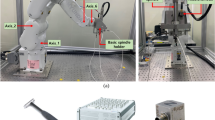Abstract
For economical reasons it is necessary to reduce the machining time and to increase the process automation. This leads to the need for fast machine tools with high process stability in order to enhance the material removal rate. However, the machine often does not limit the process stability but the tool because of its compliance. This paper presents a new possibility of expanding the stable process range of long and slender end mills with an adaptronic spindle system. The system is able to position the spindle dynamically in the range of microns with three piezo actuators. In order to disturb the regenerative effect, which leads to an instable process, the chip thickness is modulated by a dynamic spindle actuation. This is realized by a superposition of vibrations of the tool in feed direction. In milling tests the degree of stabilization is verified for different superpositions. Hence, the stable process range could be improved for spindle speeds up to 5,000 rpm.











Similar content being viewed by others
References
Neugebauer R, Denkena B, Wegener K (2007) Mechatronic systems for machine tools. Ann CIRP 56(2):657–686
Weck M, Brecher C (2006) Werkzeugmaschinen 3, Vol. 6., neu bearbeitete Auflage, Ch. 6 Prozessüberwachung, Prozessregelung, Diagnose und Instandhaltungsmaßnahmen, Springer, Berlin, pp 267–404
Altintas Y, Weck M (2004) Chatter stability of metal cutting and grinding. CIRP Ann Manuf Technol 53(2):619–642
Altintas Y, Brecher C, Weck M, Witt S (2005) Virtual machine tool. CIRP Ann Manuf Technol 54(2):115–138
Weinert K, Kersting P, Surmann T, Biermann D (2008) Modeling regenerative workpiece vibrations in five-axis milling. Prod Eng Res Dev 2:255–260
Denkena B, de Leon L, Grove T (2010) Prozessstabilität eines kordelierten Schaftfräsers. ZWF Zeitschrift für wirtschaftlichen Fabrikbetrieb, Band 105(Heft 1/2):37–41
Weck M, Brecher C (2006) Werkzeugmaschinen 5—Messtechnische Untersuchung und Beurteilung, dynamische Stabilität, vol 7, neu bearbeitete Auflage. Springer, Berlin
Altintas Y (2000) Manufacturing automation: metal cutting mechanics, machine tool vibrations, and CNC design. Cambridge University Press, Cambridge
Brecher C, Esser M (2008) The consideration of dynamic cutting forces in the stability simulation of hpc-milling processes. In: Proceedings of the 1st international conference on process machine interactions. pp 7–14
Zatarain M, Bediaga I, Munoa J, Lizarralde R (2008) Stability of milling processes with continuous spindle speed variation: analysis in the frequency and time domains, and experimental correlation. CIRP Ann Manuf Technol 57:379–384
Smith S, Tlusty J (1992) Stabilizing chatter by automatic spindle speed regulation. CIRP Ann Manuf Technol 41:433–436
Sims N, Mann B, Huyanan S (2008) Analytical prediction of chatter stability for variable pitch and variable helix milling tools. J Sound Vib 317:644–686
Altintas Y, Engin S, Budak E (1999) Analytical stability prediction and design of variable pitch cutters. ASME J Manuf Sci Eng 121:173–178
Kern S, Schiffler A, Nordmann R, Abele E (2007) Adaptronische hybridgelagerte Motorspindel zur ratterfreien HSC-Bearbeitung. VDI-Berichte 1971:307–320
Ries M (2009) Aktive Motorspindel zur Unterdrückung von Ratterschwingungen im Fräsprozess, Fortschritt-Berichte VDI Reihe 2, Fertigungstechnik 670. VDI-Verlag, Düsseldorf
Denkena B, Bickel W, Ponick B, Emmrich J (2011) Dynamic analysis of a motor-integrated method for a higher milling stability. Prod Eng Res Dev 5:691–699
Drossel W-G, Wittstock V (2008) Adaptive spindle support for improving machining operations. CIRP Ann Manuf Technol 57(1):395–398
Rashid A, Nicolescu CN (2006) Active vibration control in palletised workholding system for milling. Int J Mach Tools Manuf 46:1626–1636
Abele E, Hanselka H, Haase F, Schlote D, Schiffler A (2008) Development and design of an active work piece holder driven by piezo actuators. Prod Eng Res Dev 2:437–442
Brecher C, Manoharan D, Ladra U, Köpken H-G (2010) Chatter suppression with an active workpiece holder. Prod Eng Res Dev 4:239–245
Hesselbach J (2011) Adaptronik in Werzeugmaschinen—Forschung in Deutschland. Shaker Verlag, ISBN 978-3-8322-9809-8
Denkena B, Möhring H-C, Will JC (2007) Tool deflection compensation with an adaptronic milling spindle. International Conference on Smart Machining Systems ICSMS, Gaithersburg
Will JC (2008) Adaptronische Spindeleinheit zur Abdrängungs- und Schwingungskompensation in Fräsprozessen. Dr.-Ing. dissertation, Leibniz Universität Hannover
Denkena B, Gümmer O, Sellmeier V (2009) Static and dynamic stabilisation of a milling process by an adaptronic spindle system for milling machines. Adaptronic Congress Conference Proceedings, Berlin
Denkena B, Gümmer O (2009) Enhancement of the static and dynamic compliance of a milling machine by an adaptronic spindle system. In: Proceedings of 9th international conference of the European Society for Precision Engineering and Nanotechnology, vol. 1. pp 333–336
Denkena B, Gümmer O, Will J C, Hackeloöer F (2008) Compensation of static and dynamic tool deflections during milling processes by an adaptronic spindle system. In: 2nd international conference of innovative cutting processes & smart machining, Cluny, Burgundy, France, 22–23 Oct 2008
Möhring H-C, Litwinski K, Gümmer O (2010) Process monitoring with sensory machine tool components. CIRP Ann Manuf Technol 59:383–386
Denkena B, Gümmer O, Will J C (2011) Adaptronische Spindeleinheit für Fräsmaschinen. Adaptronik für Werkzeugmaschinen—Forschung in Deutschland. Shaker Verlag, ISBN: 978-3-8322-9809-8: 343–363
Denkena B, de Leon L, Sellmeier V (2008) Impact of the tooth pitch on the process stability of milling. In: Proceedings of the 1st international conference on process machine interactions. pp 73–82
Acknowledgments
The authors would like to thank the German Research Foundation (DFG) for their support and funding of the associated project within the priority program SPP 1156 “Adaptronics in machine tools”.
Author information
Authors and Affiliations
Corresponding author
Rights and permissions
About this article
Cite this article
Denkena, B., Gümmer, O. Process stabilization with an adaptronic spindle system. Prod. Eng. Res. Devel. 6, 485–492 (2012). https://doi.org/10.1007/s11740-012-0397-3
Received:
Accepted:
Published:
Issue Date:
DOI: https://doi.org/10.1007/s11740-012-0397-3




